
The inspiration for this recipe came from The Monet Cookbook: Recipes from Giverny by Florence Gentner and Francis Hammond. This colorful book presents recipes inspired by Monet’s culinary journals during his life at Giverny, as well as reproductions of his art work.
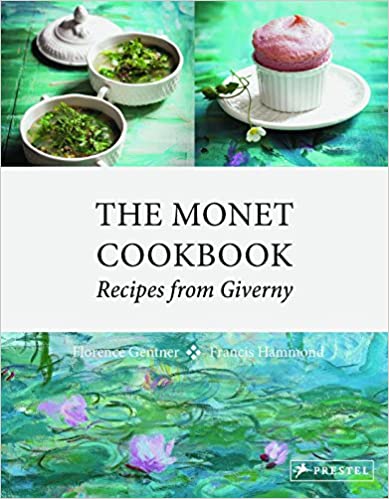
Monet moved to Giverny at age 43 with his second wife and their eight children and wound up living there another 43 years. His original motivation for the move was to gain more studio space and to enjoy a more pastoral life, however Giverny also allowed him to pursue his love of good food.
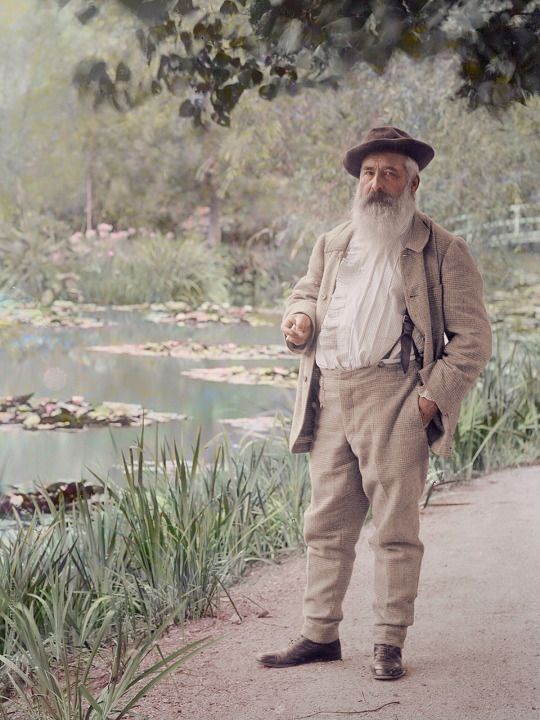
Monet found sheer joy through food but was not a cook himself, employing several cooks to prepare the food. Drawing on fresh fruits and vegetables grown from his own garden, Monet’s kitchen produced “simple dishes made of fresh ingredients and prepared according to very basic yet authentic principles.” I can just picture the gatherings around Monet’s huge dining table, that included members of his own large family, as well as frequent guests such as Renoir and Cézanne.
From Monet’s food diaries, we know that he preferred his asparagus under cooked and liked to season the duck wings himself with salt, pepper and nutmeg, before sending them back to the kitchen to be “roasted in the fires of hell.” He and his family also enjoyed making spontaneous trips inspired by their passion for food. Once, following a conversation regarding the delicious fruit tarte tatin, the entire family suddenly decided to pile into two cars and drive to Lamotte-Beuvron, home of the Tatin sisters who invented this famous tart.
Tarte Tatin recipe in ‘The Monet Cookbook‘
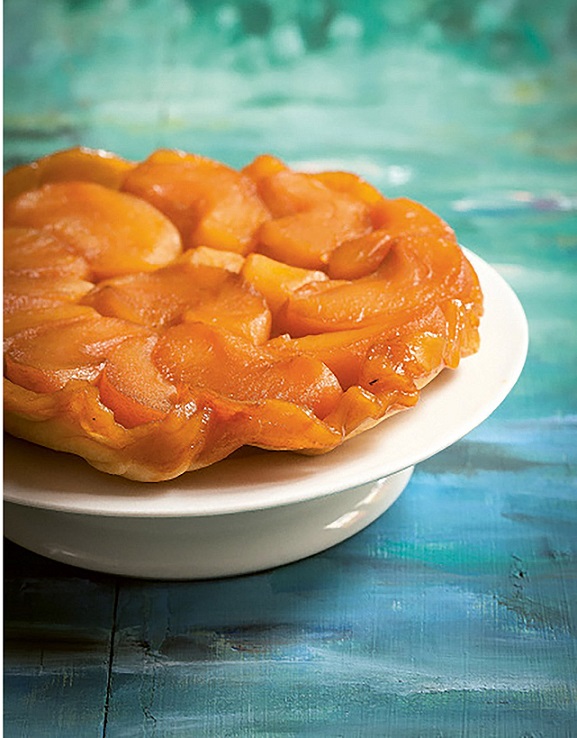
Some of the recipes in the cookbook are quite simple containing only 4-5 ingredients and some are recipes that were given to Monet by his friends, such as Paul Cézanne and his recipe for Salt Cod Bouillabaisse. I decided to try Peaches à la Bourdaloue due to its simplicity and the fact that I love peaches!
What are Peaches à la Bourdaloue?
This recipe consists of layers of custard cream (crème pastissière) and peaches that have been poached in a sugar syrup. The dish is then finished with a crispy topping of either crushed shortbread cookies or French macarons.
Interestingly, the name Bourdaloue comes from a small oblong ‘porta potty’ that women in the 1700s could hold underneath their skirts to relieve themselves while standing up. (I’m not sure how this name relates to the recipe, though)!
Photo of a Bourdaloue chamber pot
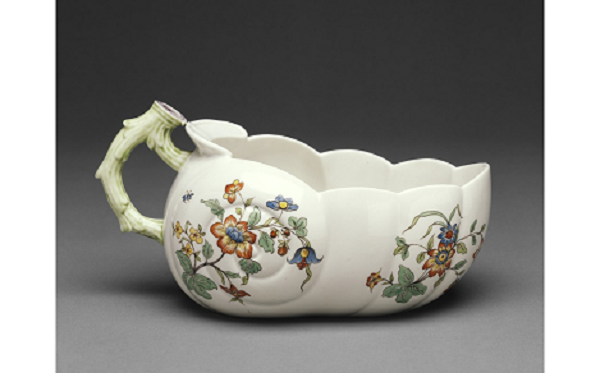
What are steps in making the recipe?
First, the peaches are peeled and halved, then poached in a sugary syrup for about 10 minutes. If you’re ‘adventurous’ like me, I added a few drops of Grand Marnier to the syrup (optional)! You could also use canned peaches, in which case you could skip this step of poaching.
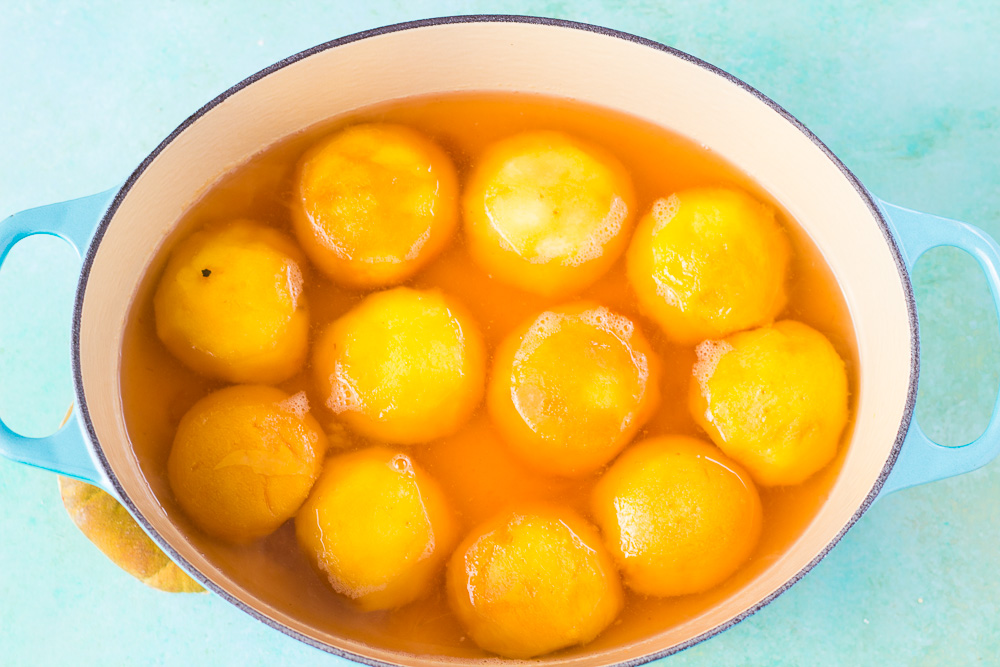
While the peaches remain soaking in the syrup, begin making the Pastry Cream Custard (Crème Pastissière).
Here, egg yolks and sugar are first whisked together, then gradually whisked into a mixture of hot milk. The custard should wind up being smooth and pliable, but not runny like pancake batter.
Now it’s time to assemble the dish: place a layer of the pastry cream on the bottom of a serving dish, followed by a layer of peaches.
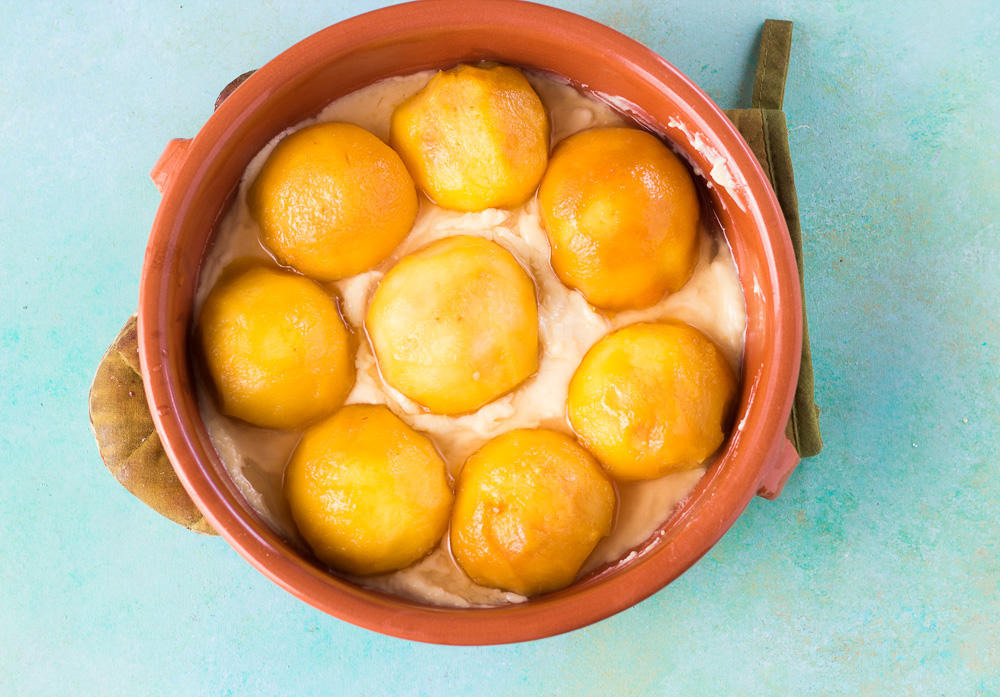
Final Topping for the recipe- crushed cookies or French macarons?
Next, the peaches are topped with a final layer of the pastry cream, then finished with a crispy topping. The recipe in the cookbook calls for a topping of “4 almond macaroons” that have been crushed. I believe this is a mis-print and should read macarons insead of macaroons (many people tend to confuse almond-based ‘macarons’ with the coconut-based ‘macaroons’).
Anyway, I used crushed shortbread cookies mixed with a few crushed pink macarons that I just happened to have on hand. You could use just the crushed cookies if you wish.
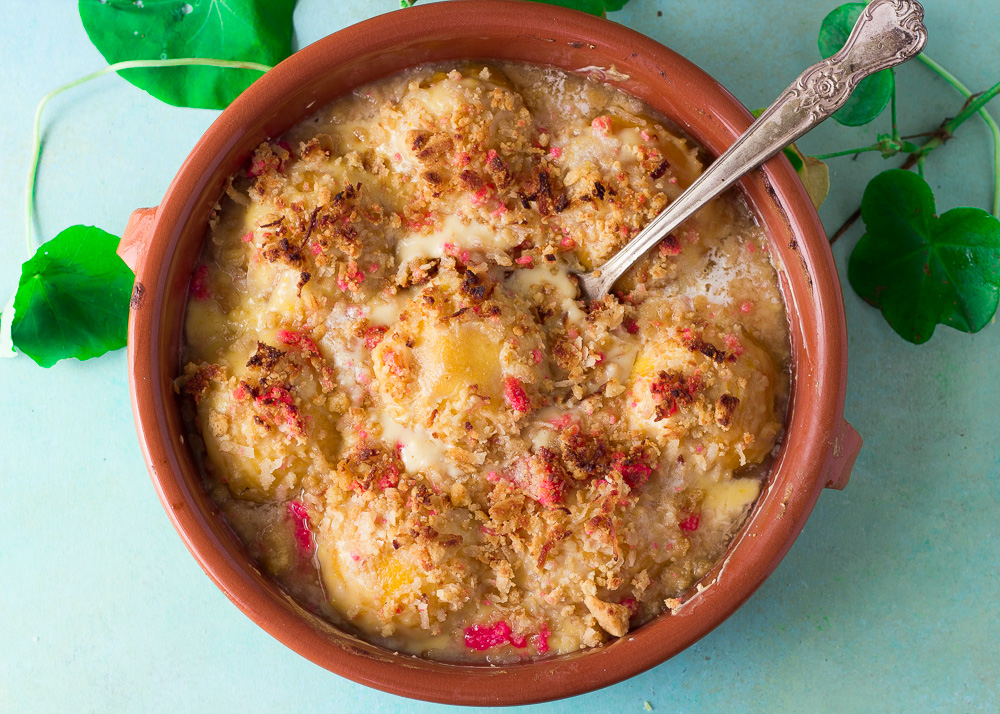
Claude Monet once said, “Beyond painting and gardening, I am good for nothing.” I think at the end of the day, Monet could also add his enjoyment of food to this brief list of things he was good at!
Bring water to boil in a medium saucepan. Dip several of the peaches at a time into the water and hold for about 1 minute until the skins loosen. Remove from water and peel the skins, cut in half and remove the pits. For the syrup, bring 2 cups water to a boil then stir in the sugar; reduce heat to low, then add the Kirsch or Grand Marnier, if using. Add the peach halves to the syrup and continue to poach them for about 6-10 minutes until the peaches soften a bit. Remove pan from heat and continue to let the peaches sit in the syrup while preparing the pastry cream. For the pastry cream, heat together the milk and vanilla flavoring until the mixture just starts to bubble- do not boil. In a separate small bowl, whisk together the sugar and egg yolks for at least 30 seconds until the mixture becomes smooth and pale yellow in color, then whisk in the flour. Over medium heat, gradually whisk in the egg/sugar mixture to the hot milk. Continue whisking until the mixture thickens. If the mixture becomes too hot, it will start to curdle. If this happens, remove the pan from the heat temporarily while continue whisking. The pastry cream should be smooth and pliable, but not runny like pancake batter. Remove from heat and let cool for about 15 minutes. Pre-heat the broiler oven to 450 F. When the pastry cream has cooled a bit, spread a layer of the cream in the bottom of a casserole dish, follow with a layer of peaches and a final layer of the pastry cream. Crush the shortbread cookies with a rolling pin and feel free to add some crushed macarons as well to the mixture. Cover the final layer of the assembled dish with this crushed topping. Dot with a little butter. Cook under the grill for a few minutes until golden and crisp. Serve warm with a little ice cream (optional).Claude Monet's Peaches à la Bourdaloue
Print Recipe
Ingredients
Instructions
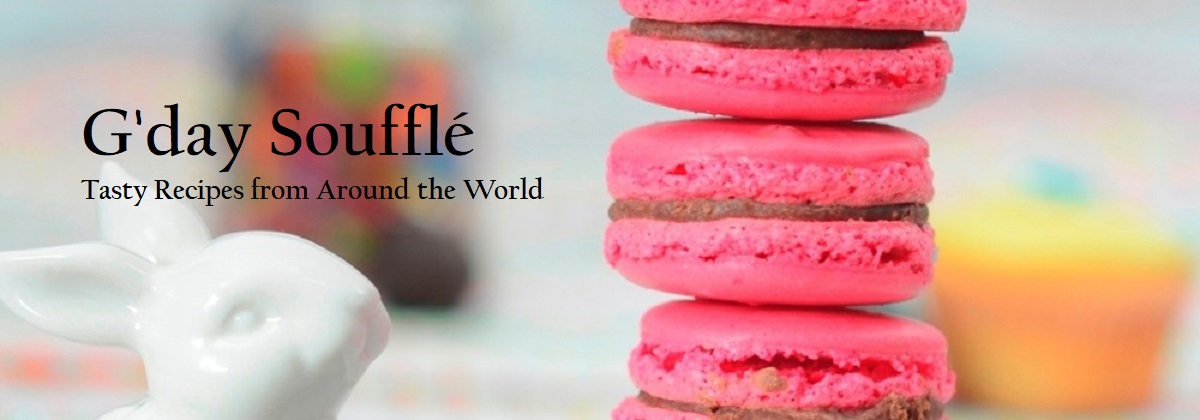

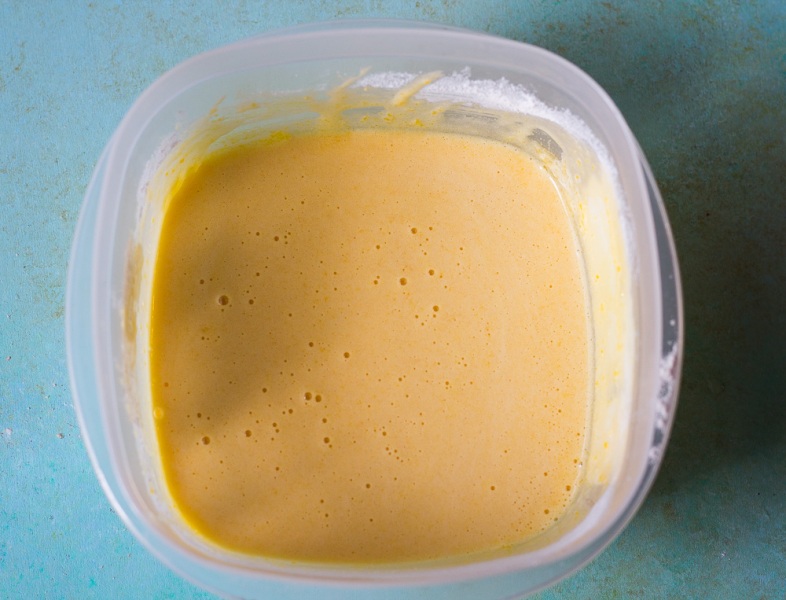


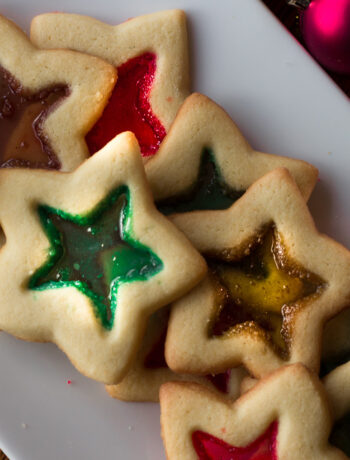

11 Comments
John / Kitchen Riffs
March 24, 2020 at 6:11 amWhat a fun post! I learned loads of new things. Didn’t know Monet was such a foodie. Such a great Tarte Tatin story. And who knew about a bourdaloue!
Plus, a great recipe. 🙂 Really neat read — thanks.
Fran Flint
March 24, 2020 at 8:36 amThanks John! I visited Giverny several years ago- next time I visit, I’ll have to pay more attention to his red/white tiled kitchen!
Angela
March 24, 2020 at 8:53 amHello,
I absolutely loved your post. Wonderful story, and sounds like a simple and delicious dessert. What did you actually think of the finished dessert…did you think it was something special, or nice enough but would make tweaks to improve it? Your critique would be greatly appreciated.
Also, I am assuming the tablespoon measure would be a 3-teaspoon one as it is a European recipe, not Australian. What measure did you use?
Many thanks from Brisbane ….and I thought I would mention that I get so excited when I see your blog posts pop up. In my opinion, they are too far between and too few for my liking!! They are always so different and really something new to make.
Regards,
Angela
Fran Flint
March 25, 2020 at 2:04 amAngela, thanks so much for your comment and it’s so good to hear from someone from Brisbane! Regarding the recipe for my post, I had already made a few tweaks- particularly for the pastry cream. The recipe in the cookbook calls for 6 egg yolks and only 1 tablespoon flour. I thought this was too many egg yolks and not enough flour, so I changed it to 3 egg yolks and 3 tablespoons flour. I’ve made pastry cream (crème pastissière) before for my profiteroles and this has worked for me. Monet’s recipe also calls for 4 almond ‘macaroons’ (which should be ‘macarons’). I assume that very few people would have French macarons lying around the house, so I substituted the crushed shortbread cookies. Other than that, I pretty much followed the recipe. I thought the dish turned out very tasty, especially after warming it up and then serving it with a little vanilla ice cream on the side. Also, I used a U.S. tablespoon measurement, which equals 15 ml versus the 20 ml Australian tablespoon measurement. If you wanted to be exact with your measurement conversion for the 3 tablespoons (US) of flour, you could measure out 28 grams of flour or use a little less than 3 tablespoons (Australian). In the end, I don’t think it needs to be that precise- you should be OK using your Australian measuring spoons. Again, thanks so much for your positive comments- they are much appreciated during these stressful times!
David Scott Allen
March 26, 2020 at 11:05 pmFun recipe and the food sounds fab! Much more interesting than Monet’s Table, although the presentation of that book is stunning! I’m glad you made a few changes to the recipe — really appreciate your expertise in these situations.
David Scott Allen
March 28, 2020 at 4:46 amHi again, so far, I like you recipe widget the best! Can you tell me which one it is? I will see if I can get it for C&L!
Fran Flint
March 28, 2020 at 6:15 amDavid, I use ‘Recipe Card’ plug-in for my recipe display. If you’re using WordPress, you can easily add this plug-in. Otherwise, it might be available on other formats as well!
David Scott Allen
April 2, 2020 at 7:42 amThanks Fran! Me excited to see if it can be added to my theme! They have their own which I don’t like!
All That I'm Eating
March 27, 2020 at 12:29 amThis looks so tempting and it sounds absolutely delicious. I’d love to try it when peaches are in season.
Juliana
March 27, 2020 at 11:25 amOh Fran, what a great post, as I love Monet, I even have an umbrella with Monet paint on it (does this sound an insult to Monet?)…this peach dessert looks and sounds absolutely amazing…I would love to dig my spoon in it and come out with a peach between pastry cream…thanks for sharing the recipe.
Have a nice rest of the week and be safe!
Raymund
April 6, 2020 at 6:42 amWow that dessert looks amazing. Interesting, I never knew Monet was a foodie.